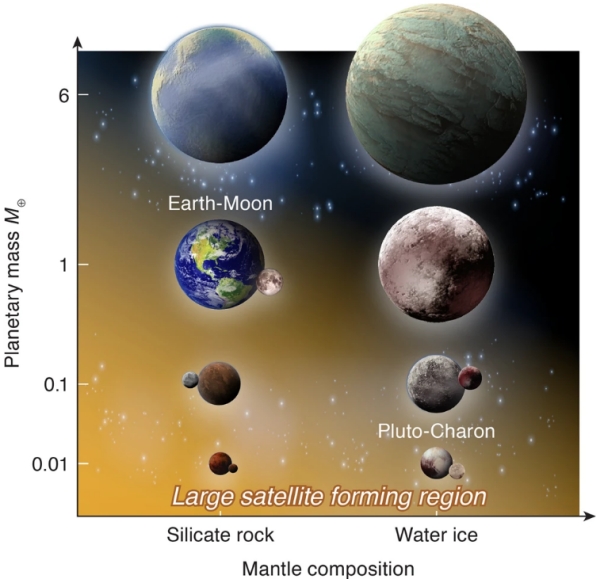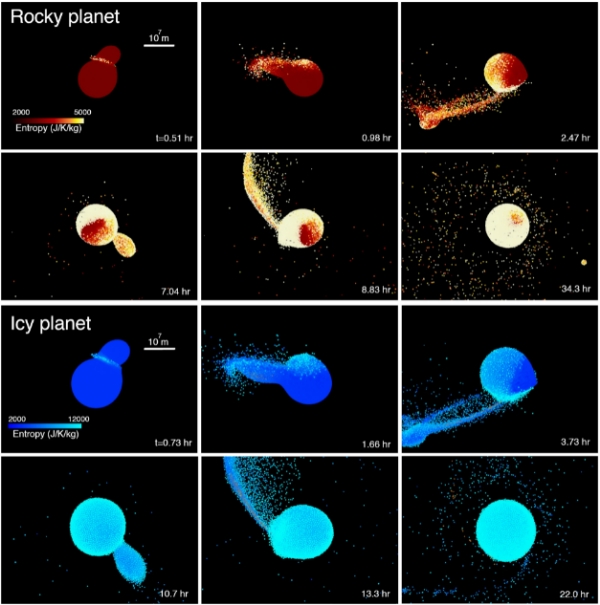Given our recent discussion of exomoon candidate Kepler-1708 b-i, a possible moon 2.6 times the mass of Earth orbiting a gas giant, I want to be sure to work in Miki Nakajima’s work on how moons form. Nakajima (University of Rochester) is first author of the paper describing this work. It’s a significant contribution because it points to a way to refine the target list for exomoon searches, one that may help us better understand where to look as we begin to flesh out a catalog of these objects..
And flesh it out we will, as the precedent of the rapidly growing exoplanet count makes clear. What I want to do today is consider how we’ve thus far proceeded. You’ll recall that when David Kipping and team performed their deep analysis of the data leading to Kepler-1708 b-i, they chose gas giants on orbits with a period of 400 days or more, so-called ‘cool worlds’ more like Jupiter than the ‘hot Jupiters’ found so frequently in early exoplanet studies. The method produced a strong candidate indeed.
But Nakajima’s work suggests that when it comes to fractionally large moons, super-Earths should be high on the target list. We need as large a moon as possible, one having the maximum gravitational effect on its planet so that it produces the most observable signature in terms of transit timing variations of the host world around its star. Working with colleagues at Tokyo Institute of Technology and the University of Arizona, Nakajima has concluded that rocky planets larger than 6 Earth masses are unlikely to produce large moons, as are icy planets larger than a single Earth mass.

Image: This is Figure 6 from the paper, titled “Schematic view of the mass range in which a fractionally large exomoon can form by an impact.” Caption: The horizontal axis represents the mantle composition and the vertical axis represents the planetary mass normalized by the Earth mass M?. Rocky planets smaller than 6?M? and icy planets smaller than 1?M? are capable of forming fractionally large moons as indicated by the orange shading. Our prediction is consistent with planet–moon systems in the solar system. Credit: Nakajima et al.
These conclusions grow out of computer simulations, modeling the kind of impact scientists generally believe produced our own fractionally large moon. In this view, the so-called Theia impactor, an object perhaps the size of Mars, struck the Earth early in its development, creating a partially vaporized disk around the planet that eventually produced the Moon. Nakajima’s team ran simulated rocky planets as well as icy worlds through collision scenarios, varying their masses and examining the resulting disks.
As to the parameters of the simulation, note this:
In this work, we use the fixed impact angle (??=?48.6°) and the impact velocity (vimp?=?vesc), where vesc is the mutual escape velocity. The impact angle and velocity are similar to those for the canonical moon-forming impact models. The reason why we explore different mass ranges for the rocky and icy planets is that the required mass for complete vaporization is different between them…
The key to the results is the nature of the debris disk. A partially vaporized disk, like the one that presumably produced our own Moon, cools in these simulations and allows accreting ‘moonlets’ to emerge. These will eventually aggregate into a moon. But when the collisional disk is fully vaporized, these constituent parts experience strong drag from the vapor, causing them to disperse and fall onto the planet before forming a moon.
The six Earth mass cutoff marks the point in these simulations at which these planetary collisions begin to produce fully vaporized disks, rendering them incapable of forming the kind of fractionally large moons that will be easiest to detect. This finding could shake things up, because thus far we have been examining a search space largely defined by gas giants. From the paper:
Our model predicts that the moon-forming disk needs to be initially liquid or solid rich, supporting the canonical moon-forming impact model. Moreover, this work will help narrow down planetary candidates that may host exomoons; we predict that planets whose radii are smaller than ~1.6R? would be good candidates to host fractionally large exomoons (?6 M? for rocky planets and ?1 M? for icy planets). These relatively small exoplanets are understudied (only four out of 57 exoplanets surveyed by the HEK [Hunt for Exomoons with Kepler] project are under this radius limit), which can potentially explain the lack of exomoon detection to date.

Image: This is Figure 1 from the paper, titled ‘Snapshots of giant impacts.’ Caption: The top two rows represent an impact between two rocky planets. The red-orange colors represent the entropy of the mantle material (forsterite). The iron core is shown in gray. The bottom two rows represent an impact between two icy planets. The blue-sky-blue colors represent the entropy of water ice, and the orange color represents forsterite. The scale represents 107?m. Credit: Nakajima et al.
Refining our target list is crucial for maximizing the return on telescope time using our various space-based assets, including the soon to be functioning James Webb Space Telescope. The paper continues:
Super-Earths are likely better candidates than mini-Neptunes to host exomoons due to their generally lower masses and potentially lower H/He gas contribution to the disk. This narrower parameter space may help constrain exomoon search in data from various telescopes, including Kepler, the Hubble space telescope, CHaraterising ExOPlanet Satellite (CHEOPS), and the James Webb Space Telescope (JWST).
As you would imagine, I went to David Kipping (Columbia University) for his thoughts on the Nakajima et al. result, he being the most visible exponent of exomoon research. His response:
“My main comment is that I’m pleased to see a testable theory regarding exomoons around terrestrial planets finally emerge. If scaled-up versions of the Earth-Moon system are out there up to 6 Earth masses, then we have a great shot at detecting those using HST/JWST.”
That science fictional trope of an Earth-sized moon orbiting a habitable zone gas giant may soon be joined by this new vision, large exomoons around super-Earths — even ‘double planets’ – which offer even more plot fodder for writers looking for exotic interstellar venues. Robert Forward’s Rocheworld inevitably comes to mind.
The paper is Nakajima et al., “Large planets may not form fractionally large moons,” Nature Communications 13, 568 (2022). Full text.



What if the planet already has moons at the time of the impact? Consider Jupiter size planets. Similar systems are likely to be common. Relatively large pre-existing moons, like the four Galilean moons, could drastically alter the dynamics while small moons might suffer the same gas drag and fate as newly accreted moonlets after the collision.
The large moons would clear their paths and may grow larger by infall from the accretion disk. The angular momentum of the impact and thus that of the disk are pretty important to the outcome yet the study appears to analyze only one impact angle.
It’s probably too soon to make any firm predictions.
Existing moons might either get a lot of material to grow, but the gravitational disturbance could send them away or drag and subsequent collisions send them to impact the central planet. The moons of Uranus is thought to be second generation – with the original ones lost.
So having existi8ng moons grow is one possibility of many.
Now that some predicted that really large moons would not exist, a collision of this kind might be what create such moons anyway.
So that hypothesis might be correct, and we’ve might be in the track of one of the exceptions. While personally I think it’s entirely random, and we eventually will find example where it be hard to say if it’s one really large moon, or if it should be named a double planet.
The problem with the double planet idea is that if the Moon is too close to the size of the planet, then the impact will completely destroy both bodies. Thea only was at a grazing angle and if it was a direct hit, we wouldn’t be here today.
Also, the Moon around a gas giant might be rare or formed probably because most large bodies past the snow line become gas giants or ice giants. A collision at a grazing angle would be an exception, with more rocky planets on a collision course in the inner solar system or exoplanet system. It might be only found in a closer region to the star since Jupiter’s Moon’s clearly formed from an accretion disk due to their similar size and distance from the Jupiter.
The size or type of the star is also a factor not mentioned here.
John Michael Godier’s most recent Event Horizon podcast: Habitable Exomoons? w/ David Kipping of Cool Worlds stirs the pot of food for thought…
How is it known what 6 times earth rocky mass planet looks like?
Take two earths and crash them together, what is gravity of planet formed
by the collision?
Would one have different gravity results with different velocity impact collisions?
You can take Venus, Earth, Mercury and Mars plus all of the satellites that exist in the solar system and all of the dwarf planets and all of the asteroids and you still do not have more then a 3 earth mass planet. We have no idea what super earths will be like, there is nothing in the solar system like them. In the next year we should have a better understanding of what they are like after the JWST studies the Trappist 1 system and the many other transisting super earths. As for moons around these planets it is too early to tell but we may know more about thier satellites from JWST also. We need to look at these world from the prospective of earth not even existing since this heavily biasis our studies and results. Maybe AI can help with this since humans are mostly crossed eyed, the double-blinded AI’s are not… ;-}
There’s a chance that we do indeed have our own super Earth, at least it hasn’t been ruled out yet. Maybe the JWST will help find the putative Planet 9, as well as its moon!
Whatever’s going on with exomoons, I’m looking forward to the new developments!